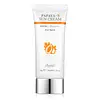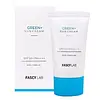What's inside
What's inside
 Key Ingredients
Key Ingredients

 Benefits
Benefits

 Concerns
Concerns

 Ingredients Side-by-side
Ingredients Side-by-side

Carica Papaya Fruit Water 43%
Skin ConditioningTitanium Dioxide
Cosmetic ColorantEthylhexyl Methoxycinnamate
UV AbsorberZinc Oxide
Cosmetic ColorantOctyldodecanol
EmollientDicaprylyl Carbonate
EmollientCoco-Caprylate/Caprate
EmollientC12-15 Alkyl Benzoate
AntimicrobialCetyl PEG/PPG-10/1 Dimethicone
EmulsifyingPentylene Glycol
Skin ConditioningNiacinamide
SmoothingHelianthus Annuus Seed Oil
EmollientDiethylamino Hydroxybenzoyl Hexyl Benzoate
UV FilterGlycerin
HumectantBis-Ethylhexyloxyphenol Methoxyphenyl Triazine
Skin ConditioningWater
Skin Conditioning1,2-Hexanediol
Skin ConditioningPolyglyceryl-3 Diisostearate
EmulsifyingMagnesium Sulfate
Beeswax
Emulsion StabilisingAluminum Hydroxide
EmollientDimethicone
EmollientPropanediol
SolventHydrogen Dimethicone
Disteardimonium Hectorite
StabilisingCarica Papaya Seed Oil
HumectantGlyceryl Caprylate
EmollientDimethicone/Vinyl Dimethicone Crosspolymer
Skin ConditioningTriethoxycaprylylsilane
Panthenol
Skin ConditioningButyrospermum Parkii Butter
Skin ConditioningBeta-Glucan
Skin ConditioningCarica Papaya Fruit Extract
Skin ConditioningXanthan Gum
EmulsifyingXylitylglucoside
HumectantAnhydroxylitol
HumectantXylitol
HumectantAdenosine
Skin ConditioningCarthamus Tinctorius Bud Extract
Skin ConditioningDisodium Adenosine Triphosphate
Skin ConditioningPapain
Skin ConditioningAlgin
MaskingGlucose
HumectantGeranium Maculatum Oil
MaskingCarica Papaya Fruit Water 43%, Titanium Dioxide, Ethylhexyl Methoxycinnamate, Zinc Oxide, Octyldodecanol, Dicaprylyl Carbonate, Coco-Caprylate/Caprate, C12-15 Alkyl Benzoate, Cetyl PEG/PPG-10/1 Dimethicone, Pentylene Glycol, Niacinamide, Helianthus Annuus Seed Oil, Diethylamino Hydroxybenzoyl Hexyl Benzoate, Glycerin, Bis-Ethylhexyloxyphenol Methoxyphenyl Triazine, Water, 1,2-Hexanediol, Polyglyceryl-3 Diisostearate, Magnesium Sulfate, Beeswax, Aluminum Hydroxide, Dimethicone, Propanediol, Hydrogen Dimethicone, Disteardimonium Hectorite, Carica Papaya Seed Oil, Glyceryl Caprylate, Dimethicone/Vinyl Dimethicone Crosspolymer, Triethoxycaprylylsilane, Panthenol, Butyrospermum Parkii Butter, Beta-Glucan, Carica Papaya Fruit Extract, Xanthan Gum, Xylitylglucoside, Anhydroxylitol, Xylitol, Adenosine, Carthamus Tinctorius Bud Extract, Disodium Adenosine Triphosphate, Papain, Algin, Glucose, Geranium Maculatum Oil
Water
Skin ConditioningButylene Glycol
HumectantC12-15 Alkyl Benzoate
AntimicrobialMethyl Methacrylate Crosspolymer
1,2-Hexanediol
Skin ConditioningDiethylamino Hydroxybenzoyl Hexyl Benzoate
UV FilterNiacinamide
SmoothingBehenyl Alcohol
EmollientBis-Ethylhexyloxyphenol Methoxyphenyl Triazine
Skin ConditioningPotassium Cetyl Phosphate
EmulsifyingSodium Acrylate/Sodium Acryloyldimethyl Taurate Copolymer
Emulsion StabilisingPolyisobutene
Ammonium Acryloyldimethyltaurate/Vp Copolymer
Silica
AbrasiveAdenosine
Skin ConditioningXylitylglucoside
HumectantCaprylyl/Capryl Glucoside
CleansingDisodium EDTA
Sorbitan Oleate
EmulsifyingAnhydroxylitol
HumectantXylitol
HumectantSodium Hyaluronate
HumectantGlucose
HumectantWater, Butylene Glycol, C12-15 Alkyl Benzoate, Methyl Methacrylate Crosspolymer, 1,2-Hexanediol, Diethylamino Hydroxybenzoyl Hexyl Benzoate, Niacinamide, Behenyl Alcohol, Bis-Ethylhexyloxyphenol Methoxyphenyl Triazine, Potassium Cetyl Phosphate, Sodium Acrylate/Sodium Acryloyldimethyl Taurate Copolymer, Polyisobutene, Ammonium Acryloyldimethyltaurate/Vp Copolymer, Silica, Adenosine, Xylitylglucoside, Caprylyl/Capryl Glucoside, Disodium EDTA, Sorbitan Oleate, Anhydroxylitol, Xylitol, Sodium Hyaluronate, Glucose
Ingredients Explained
These ingredients are found in both products.
Ingredients higher up in an ingredient list are typically present in a larger amount.
1,2-Hexanediol is a synthetic liquid and another multi-functional powerhouse.
It is a:
- Humectant, drawing moisture into the skin
- Emollient, helping to soften skin
- Solvent, dispersing and stabilizing formulas
- Preservative booster, enhancing the antimicrobial activity of other preservatives
Adenosine is in every living organism. It is one of four components in nucleic acids that helps store our DNA.
Adenosine has many benefits when used. These benefits include hydrating the skin, smoothing skin, and reducing wrinkles. Once applied, adenosine increases collagen production. It also helps with improving firmness and tissue repair.
Studies have found adenosine may also help with wound healing.
In skincare products, Adenosine is usually derived from yeast.
Learn more about AdenosineThis ingredient is created from dehydrating xylitol in acidic conditions. Xylitol is a famous sugar and humectant.
Much like its predecessor, anhydroxylitol is a humectant. Humectants attract and hold water to moisturize the skin.
This ingredient is most commonly found in a popular trio called Aquaxyl. Aquaxyl is made up of anhydroxylitol (24 - 34%), xylitylglucoside (35 - 50%), and xylitol (5 - 15%).
According to a manufacturer, Aquaxyl is known for a 3-D hydration concept and an anti-dehydration shield to reinforce the outer layer of skin.
This ingredient is often derived from plants such as wood and sugarcane.
Learn more about AnhydroxylitolYou might know this ingredient as Tinosorb S or Bemotrizinol. It is a UV filter that covers both UVA and UVB rays.
This ingredient has two peak UV absorption peaks ( 310 and 340 nm) and is able to absorb both UV-A and UV-B rays. This ingredient works by preventing UV rays from reaching and damaging your skin.
On top of that - it is highly photostable and helps prevent the photodegration of other sunscreen ingredients such as avobenzone.
Tinosorb S is allowed in the EU, Australia, and Asia. It is close to being approved by the FDA and we'll hopefully get this ingredient in the U.S. by late 2025.
Fun fact: Tinosorb S is the most effective UV absorber at maximum concentration (measured by SPF) permitted in the EU.
This ingredient is oil-soluble, so your oil-cleansers will take this right off at night.
Learn more about Bis-Ethylhexyloxyphenol Methoxyphenyl TriazineC12-15 Alkyl Benzoate is made up of Benzoic Acid and long chain alcohols. It has a low molecular weight.
C12-15 Alkyl Benzoate is an emollient and texture enhancer. Due to its solubility, it is often used in sunscreens to help evenly distribute active ingredients.
As an emollient, C12-15 Alkyl Benzoate helps soften and hydrate your skin. Emollients create a film on your skin that traps moisture within.
This ingredient has been reported to cause eye irritation.
Learn more about C12-15 Alkyl BenzoateDiethylamino Hydroxybenzoyl Hexyl Benzoate (DHHB) is a chemical UV-A absorber. It is formulated for high UVA protection (320-400 nm).
DHHB is well-liked for:
DHHB has been approved by the EU, Japan, Taiwan, and South America for use up to 10%. Unfortunately, it has not been approved for use in the US or Canada due to slow regulatory processes.
This ingredient is soluble in oils, fats, and lipids.
Learn more about Diethylamino Hydroxybenzoyl Hexyl BenzoateGlucose is a simple sugar and is the most important source of energy in all organisms.
In skincare, glucose is used to hydrate the skin. It also acts as a prebiotic for our natural biome.
Glucose is hydrating due to its humectant property. As a humectant, glucose draws moisture from the air and from deeper levels in the skin.
Our skin contains many sugars that act as prebiotics and help strengthen our natural microbiome. Having a healthy microbiome helps protect our skin from harmful bacteria and other contaminants.
Studies show glucose may help with fading discoloration and pigmentation. This is because our skin metabolizes glucose into lactic acid. Lactic acid is an AHA that helps exfoliate the top layer of skin.
Learn more about GlucoseNiacinamide is a multitasking form of vitamin B3 that strengthens the skin barrier, reduces pores and dark spots, regulates oil, and improves signs of aging.
And the best part? It's gentle and well-tolerated by most skin types, including sensitive and reactive skin.
You might have heard of "niacin flush", or the reddening of skin that causes itchiness. Niacinamide has not been found to cause this.
In very rare cases, some individuals may not be able to tolerate niacinamide at all or experience an allergic reaction to it.
If you are experiencing flaking, irritation, and dryness with this ingredient, be sure to double check all your products as this ingredient can be found in all categories of skincare.
When incorporating niacinamide into your routine, look out for concentration amounts. Typically, 5% niacinamide provides benefits such as fading dark spots. However, if you have sensitive skin, it is better to begin with a smaller concentration.
When you apply niacinamide to your skin, your body converts it into nicotinamide adenine dinucleotide (NAD). NAD is an essential coenzyme that is already found in your cells as "fuel" and powers countless biological processes.
In your skin, NAD helps repair cell damage, produce new healthy cells, support collagen production, strengthen the skin barrier, and fight environmental stressors (like UV and pollution).
Our natural NAD levels start to decline with age, leading to slower skin repair, visible aging, and a weaker skin barrier. By providing your skin niacinamide, you're recharging your skin's NAD levels. This leads to stronger, healthier, and younger looking skin.
Another name for vitamin B3 is nicotinamide. This vitamin is water-soluble and our bodies don't store it. We obtain Vitamin B3 from either food or skincare. Meat, fish, wheat, yeast, and leafy greens contain vitamin B3.
The type of niacinamide used in skincare is synthetically created.
Learn more about NiacinamideWater. It's the most common cosmetic ingredient of all. You'll usually see it at the top of ingredient lists, meaning that it makes up the largest part of the product.
So why is it so popular? Water most often acts as a solvent - this means that it helps dissolve other ingredients into the formulation.
You'll also recognize water as that liquid we all need to stay alive. If you see this, drink a glass of water. Stay hydrated!
Learn more about WaterXylitol is a humectant and prebiotic. It can help with dry skin.
In studies, xylitol has been shown to improve dry skin. It decreased transepidermal water loss, or when water passes through the skin and evaporates. Xylitol also showed to help improve the biomechanical properties of the skin barrier.
The prebiotic property of xylitol may also help reinforce our skin's natural microbiome. Having a healthy microbiome prevents infection by bad bacteria and helps with hydration.
As a humectant, Xylitol helps draw moisture from both the air and from deeper skin layers. This helps keep skin hydrated.
Xylitol is a sugar alcohol and commonly used as a sugar substitute. It is naturally occurring in plants such as strawberries and pumpkin.
Learn more about XylitolXylitylglucoside is created from xylitol and glucose, two humectants.
Not surprisingly, this ingredient is also a humectant. It attracts and holds water in your skin, helping to maintain hydration.
This ingredient is most commonly found in a popular trio called Aquaxyl. Aquaxyl is made up of anhydroxylitol(24 - 34%), xylitylglucoside (35 - 50%), and xylitol (5 - 15%).
According to a manufacturer, Aquaxyl is known for a 3-D hydration concept and an anti-dehydration shield to reinforce the outer layer of skin.
Learn more about Xylitylglucoside